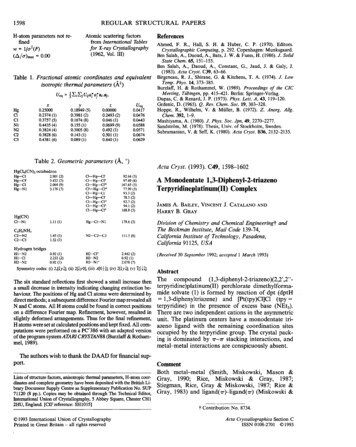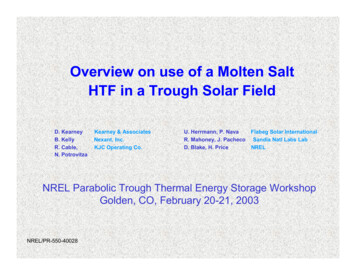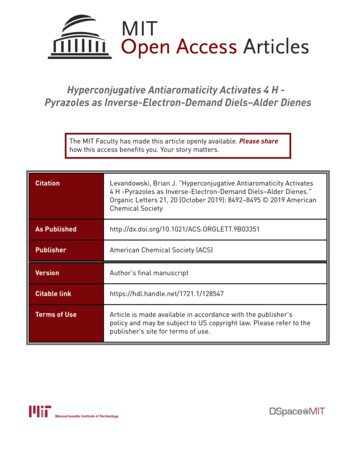
Transcription
REGULAR STRUCTURAL PAPERS1598H-atom parameters not refinedw l/u 2 (F)(D,,./u)max 0.00Atomic scattering factorsfrom International Tablesfor X-ray Crystallography( 1962, Vol. III)Table 1. Fractional atomic coordinates and equivalentisotropic thermal parameters (A2 )HgClClNlN2C2C3xyzUeq0.250000.2374 (1)0.3757 (5)0.4435 (4)0.3824 (4)0.3828 (6)0.4381 (6)0.18949 (5)0.3981 (2)0.1674 (8)0.155 (1)0.3005 (8)0.143 (1)0.089 (1)0.000000.2493 (2)0.046 (1)0.0699 (9)0.492 (1)0.501 (1)0.640 (1)0.04170.04760.04430.05880.05710.06740.0629Table 2. Geometric parameters (A,HgCl.i(CN) 2 octahedronHg-Cl2.901 (2)Hg-Cl;3.432 (2)Hg-Cl2.064 (9)Hg-NI3.176 (7)Hg(CN)0-NlAhmed, F. R., Hall, S. H. & Huber, C. P. (1970). Editors.Crystallographic Computing, p. 292. Copenhagen: Munksgaard.Ben Salah, A., Daoud, A., Bats, J. W. & Fuess, H. (1986). J. SolidState Chem. 65, 151-155.Ben Salah, A., Daoud, A., Constant, G., Jaud, J. & Galy, J.(1983). Acta Cryst. C39, 63-66.Birgeneau, R. J., Shirane, G. & Kitchens, T. A. (1974). J. LowTemp. Phys. 14, 37J-385.Burzlaff, H. & Rothammel, W. (1989). Proceedings of the CICMeeting, TU"bingen, pp. 415-421. Berlin: Springer-Verlag.Dupas, C. & Renard, J.P. (1973). Phys. Lett. A, 43, 119-120.Grdenic, D. (1965). Q. Rev. Chem. Soc. 19, 303-328.Hoppe, R., Wilhelm, V. & Muller, B. (1972). Z. Anorg. Alig.Chem. 392, 1-9.Mashiyama, A. (1980). J. Phys. Soc. Jpn, 49, 2270-2277.Sandstrom, M. (1978). Thesis, Univ. of Stockholm, Sweden.Subramanian, V. & Seff, K. (1980). Acta Cryst. B36, 2132-2135.0)Acta Cryst. (1993). C49, 4 (5)97.69 (6)167.65 (5)77.99 (5)93.3 (2)78.5 (2)92.7 (2)94.1 (2)168.8 (3)I.I I (!)Hg-Cl-NI179.6 (5)1.45 (I)1.52 (I)N2--C2-C3111.5 (8)H2 . ·Cl''H3···N2H3···Nl'2.442 (2)0.92 (I)2.078 (7)Hydrogen bridgesHl . ·N20.92 (I)HI . CJ2.233 (2)0.92 (I)H2 . ·N2ReferencesSymmetry codes: (i) 2 1 [!y ]; (ii) 2[ y0]; (iii) A[OH]; (iv) 2[iy ]; (v)A Monodentate 1,3-Diphenyl-2-triazenoTerpyridineplatinum(II) ComplexJAMESA.HARRYBAILEY, VINCENT J. CATALANO ANDB.GRAYDivision of Chemistry and Chemical Engineeringt andThe Beckman Institute, Mail Code 139-74,California Institute of Technology, Pasadena,California 91125, USA(Received 30 September 1992; accepted 1 March 1993)T[WJ.The six standard reflections first showed a small increase thena small decrease in intensity indicating changing extinction behaviour. The positions of Hg and Cl atoms were determined bydirect methods; a subsequent difference Fourier map revealed allN and C atoms. All H atoms could be found in correct positionson a difference Fourier map. Refinement, however, resulted inslightly deformed arrangements. Thus for the final refinement,H atoms were set at calculated positions and kept fixed. All computations were performed on a PC' 386 with an adapted versionof the program system ATARI CRYSTAN88 (Burzlaff & Rothammel, 1989).AbstractThe compound (l ,3-diphenyl-2-triazeno)(2,2' ,2"terpyridine)platinum(II) perchlorate dimethylformamide solvate (1) is formed by reaction of dpt (dptH 1,3-diphenyltriazene) and [Pt(tpy)Cl]Cl (tpy terpyridine) in the presence of excess base (NEt3).There are two independent cations in the asymmetricunit. The platinum centers have a monodentate triazeno ligand with the remaining coordination sitesoccupied by the terpyridine group. The crystal packing is dominated by TT-TT stacking interactions, andmetal-metal interactions are conspicuously absent.The authors wish to thank the DAAD for financial support.CommentBoth metal-metal (Smith, Miskowski, Mason &Lists of structure factors, anisotropic thermal parameters, H-atom coor- Gray, 1990; Rice, Miskowski & Gray, 1987;dinates and complete geometry have been deposited with the British LiStiegman, Rice, Gray & Miskowski, 1987; Rice &brary Docwnent Supply Centre as Supplementary Publication No. SUP71120 (8 pp.). Copies may be obtained through The Technical Editor, Gray, 1983) and ligand(TT}-ligand(7r) (Miskowski &International Union of Crystallography, 5 Abbey Square, Chester CH 12HU, England. [CIF reference: SH1015] 1993 International Union of CrystallographyPrinted in Great Britain - all rights reservedt Contribution No.8734.Acta Crysta/lographica Section CISSN 0108-2701 1993
REGULAR STRUCTURAL PAPERSHoulding, 1991) interactions can strongly influencethe spectroscopic properties of (a-diimine)platinumcomplexes. Our recent work in this area has centeredon the triazenido ligand because it is well known toform bridged complexes with relatively short metalmetal distances (Moore & Robinson, 1986). Mononuclear monodentate triazenido complexes arerelatively rare, and the limited examples occurmostly with the platinum-group metals (Bombieri,Immirzi & Toniolo, 1976; Brown & lbers, 1976a,b).We have prepared a mononuclear complex [Pt(tpy)(dpt)](Cl04) (1) (dptH 1,3-diphenyltriazene, tpy terpyridine) with a monodentate dpt ligand; thiscomplex is deep green and displays dichroicbehavior. The crystal and molecular structure of (I)is described herein.1599Cl251Fig. 1. A drawing of the cations (50% probability ellipsoids foranisotropic atoms) showing the numbering system. H atoms arenot shown.Cation of (1)Compound (1) was prepared by reaction of[Pt(tpy)Cl]Cl.H 2 0 in aqueous acetone with one halfequivalent of dpt and excess Et 3 N. Although thestoichiometry should have promoted binuclear complex formation, the triazeno-bridged species was notdetected. Small deep-red tabular blocks were grownby slow diffusion of ether into a DMF (dimethylformamide) solution. There are two independentcations in the structure, which are shown in Fig. Iwith atom labels; Fig. 2 shows the packing arrangement aligned to show the aromatic ring stacking. Therestricted bite angle of the tridentate terpyridineligand has caused a small distortion at each Pt atomfrom a square-planar geometry; this distortion iscommonly observed in terpyridine complexes(Dewan, Lippard & Bauer, 1980; Ratilla, Scott,Moxness & Kostic, 1990; Wong & Lippard, 1977;Jennette, Gill, Sadownick & Lippard, 1976; Bailey &Gray, 1992; Bailey, Miskowski & Gray, 1993). As aconsequence, the cis N-Pt-N angles within thefour metallocyclic rings are less than 90 (between80. l and 80.7 ). The Pt(l)-N(2) and the Pt(2)N(8) lengths are relatively short [1.941 (10) and1.943 (9) A]; this also is a result of the geometricalconstraints imposed by the tpy ligand.The remaining bond lengths and angles in thecations are unremarkable; however, extensive inter-Fig. 2. A drawing showing stacking interactions between cations.Pt and N atoms are shown as 50% probability ellipsoids; Catoms as 10%; H atoms are not shown.molecular interactions between cations occur viastacking of the rr systems of both the terpyridine andtriazeno ligands. The interaction involves aromaticrings from four neighboring molecules (see Fig. 2);two tpy ligands [one from a Pt(l) and one from aPt(2) fragment] form the interior of a short stack andhave a closest contact of under 3.4 A [C(l2)···N(8)3.387 (16), C(l4)-··N(7) 3.316 (15) A]. This distanceis well within the value (3.8 A) normally associatedwith a significant TT-TT interaction (Hunter &Sanders, 1990). The stack is completed on each sideby a phenyl group from a triazeno ligand. ThePt( 1) side is capped by an a-phenyl group withclosest contacts of just over 3.4 A. [C(46)···N(3)3.489 (15), C(47)···C(l l) 3.454 (18) A], while thePt(2) side has a y-phenyl at around 3.4 A [C(52)···C(34) 3.348 (19), C(49)···C(31) 3.416 (18) A]. Thesetwo phenyl groups are both from Pt(2) fragments.Each set of four aromatic systems is linked to the
@REGULAR STRUCTURAL PAPERS1600next through a Pt(2) fragment to form a helicalnetwork throughout the crystal. Although Ptllcompounds are known to aggregate into oligomericchains supported by metal-metal interactions only,the platinum-platinum distances far exceed thosethat are close enough for appreciable bonding. Theclosest arroach is between Pt(l) and Pt(2)[6.913 (6) ], and all other Pt· . Pt distances aregreater than 8 A. The stacking in this crystal structure exclusively involves the aromatic 7r systems.ExperimentalCrystal dataDx 1.77 Mg m- 3Mo Ka radiationA 0.71073 ACell parameters from 24reflections(J 6.35- 12.42 µ 4.830 mm- 1T 130 KRodsRed-brownCrystal source: DMF/ether{[Pt(C1sHuN3)(C12H10N3)](Cl04).C3H1NO }2Mr 1594.30MonoclinicP2ifca 15.610 (4)Ab 14.809 (5) c 25.918 (9) A/3 92.34 (2) 0v 5986 (3) A3Z 4Data collection6961 observed reflections[F 4u(F)]Omax 25 h -18-dSk 0- 17l 0- 302 standard reflectionsmonitored every 198reflectionsintensity variation: 2 %Nicolet K3m/V diffractometerw scansAbsorption correction:refined from AFTmin 0.806, Tmax 0.83310552 measured reflections10552 independent reflectionsRefinementRefinement on FFinal R 0.056wR 0.058 1.096961 reflections476 parametersw l/[u2 (F) 0.0004F2 ](A/u)lll11X 0.11 for C(33);0.02 for all othersApJ[Jll 1.63 e A- 3Apmm -1.19 e A- 3Atomic scattering factorsfrom Cromer (1974);Cromer & Waber (1974)sTable 1. Fractional atomic coordinates and equivalentisotropic thermal parameters )x0.1212 (1)-0.4375 (1)0.1322 (2)0.6442 (2)0.0472 (7)0.1889 (8)0.1389 (7)0.1556 (7)0.6483 (8)0.6886 (10) p:::,i jUija;aja;.&j.yz0.0487 (1)0.0821 (1)0.1770 (2)0.1817 (2)0.1915 (8)0.2368 (7)0.1921 (8)0.0860 (6)0.1881 (10)0.2517 (10)0.1994 (1)0.1947 (1)0.0275 (1)0.0405 (1)0.0079 (5)0.0032 (4)0.0823 (3)0.0173 (4)0.0943 (4)0.0187 (6)Ueq0.0023 (1)0.0022 (1)0.0034 (1)0.0035 (1)0.0079 (5)0.0073 (5)0.0068 (5)0.0061 (4)0.0096 (6)0.0117 4)0(10)C(58)C(59)C(60)0.5567 (7)0.6842 (7)0.0127 (6)0.1451 (6)0.2393 (6)0.0967 (6)0.0723 (6)0.0758 (7)-0.5249 (6)-0.5261 (7)-0.3795 (6)-0.3450 (6)-0.3401 (6)-0.4015 (6)-0.0544 (8)-0.1252 (8)-0.1274 (9)-0.0602 (8)0.0086 (8)0.0856 (8)0.1003 (8)0.1760 (9)0.2386 (8)0.2215 (8)0.2748 (8)0.3572 (8)0.4050 (8)0.3668 (8)0.2849 (8)0.1016 (8)0.0931 (8)0.0967 (9)0.1088 (9)0.1158 (9)0.1128 (8)0.0438 (9)0.0617 (8)0.0266 (9)-0.0280 (10)-0.0465 (11)-0.0132 (9)-0.5208 (9)-0.5864 (8)-0.6617 (9)-0.6661 (8)-0.5974 (7)-0.5984 (8)-0.6639 (8)-0.6516 (9)-0.5785 (8)-0.5134 (8)-0.4298 (8)-0.3999 (8)-0.3195 (9)-0.2687 (9)-0.3007 (8)-0.2792 (7)-0.2075 (8)-0.1450 (8)-0.1511 (8)-0.2222 (8)-0.2862 (8)-0.3901 (8)-0.4618 (9)-0.4582 (10)-0.3800 (9)-0.3075 (9)-0.3115 (8)0.2612 (9)0.3242 (8)0.2005 (12)0.3022 (12)0.2701 (12)0.4297 (8)0.4410 (6)0.3393 (9)0.4659 (11)0.4707 (11)0.1778 (9)0.0974 (8)0.0657 (7)-0.0344 (7)0.0057 (7)0.1367 (7)0.1053 (7)0.0195 (8)0.1686 (7)0.0700 (6)-0.0090 (7)0.0949 (6)0.0421 (7)-0.0153 (7)0.1191 (9)0.1257 (9)0.0709 (9)0.0163 (9)0.0106 (9)-0.0450 (9)-0.1071 (9)-0.1519 (10)-0.1382 (9)-0.0792 (9)-0.0549 (8)-0.0876 (9)-0.0562 (8)0.0048 (8)0.0354 (8)0.2299 (8)0.2875 (8)0.3806 (10)0.4202 (10)0.3605 (9)0.2688 (9)-0.0098 (9)-0.1009 (9)-0.1342 (10)-0.0856 (11)0.0021 (12)0.0399 (10)0.2144 (9)0.2669 (9)0.2741 (9)0.2247 (9)0.1742 (8)0.1196 (8)0.1084 (9)0.0474 (9)-0.0008 (9)0.0102 (8)-0.0341 (9)-0.0939 (9)-0.1297 (9)-0.1072 (9)-0.0447 (8)0.1604 (8)0.1588 (9)0.2261 (9)0.2957 (9)0.2946 (9)0.2302 (8)-0.0689 (8)-0.1125 (9)-0.1667 (10)-0.1789 (10)-0.1388 (9)-0.0831 (9)0.0416 (10)0.1357 (9)0.0299 (13)-0.0407 (13)0.1216 (13)0.6469 (8)0.7781 (7)0.6373 (11)0.5827 (11)0.7162 (11)0.0212 (4)0.0267 (5)0.1549 (4)0.1439 (4)0.2235 (3)0.2582 (3)0.3036 (4)0.3080 (4)0.2221 (3)0.1403 (3)0.1489 (3)0.2515 (4)0.2932 (3)0.2968 (4)0.1640 (5)0.1303 (5)0.0865 (5)0.0774 (5)0.1111 (4)0.1050 (4)0.0668 (5)0.0679 (5)0.1068 (5)0.1456 (4)0.1913 (4)0.2010 (4)0.2441 (5)0.2775 (4)0.2661 (4)0.2537 (4)0.2962 (5)0.2895 (5)0.2406 (5)0.1992 (5)0.2056 (5)0.3552 (5)0.3700 (5)0.4140 (5)0.4428 (6)0.4284 (6)0.3849 (5)0.2663 (5)0.2814 (5)0.2512 (5)0.2052 (5)0.1904 (4)0.1448 (4)0.1064 (5)0.0669 (5)0.0640 (5)0.1023 (4)0.1075 (5)0.0718 (5)0.0781 (5)0.1202 (5)0.1550 (5)0.2508 (4)0.2863 (5)0.2838 (5)0.2486 (5)0.2132 (5)0.2147 (5)0.3415 (4)0.3593 (5)0.4020 (5)0.4275 (5)0.4112 (5)0.3671 (5)0.4298 (5)0.3744 (5)0.4681 (7)0.4130 (7)0.4082 (7)0.0769 (4)0.1227 (4)0.0852 (6)0.0421 (6)0.0952 (6)0.0091 (6)0.0082 (5)0.0028 (4)0.0025 (3)0.0025 (3)0.0025 (3)0.0030 (4)0.0035 (4)0.0026 (3)0.0026 (3)0.0026 (3)0.0024 (3)0.0019 (3)0.0028 (4)0.0030 (3)0.0034 (3)0.0039 (4)0.0036 (3)0.0026 (3)0.0025 (3)0.0032 (3)0.0042 (4)0.0031 (3)0.0026 (3)0.0026 (3)0.0027 (3)0.0031 (3)0.0026 (3)0.0026 (3)0.0025 (3)0.0029 (3)0.0040(4)0.0044(4)0.0041 (4)0.0033 (3)0.0035 (3)0.0035 (3)0.0042(4)0.0052 (4)0.0061 (5)0.0041 (4)0.0035 (3)0.0034 (3)0.0035 (3)0.0034 (3)0.0021 (3)0.0027 (3)0.0031 (3)0.0038 (3)0.0031 (3)0.0026 (3)0.0031 (3)0.0035 (3)0.0038 (3)0.0039 (4)0.0029 (3)0.0023 (3)0.0030 (3)0.0034 (3)0.0034 (3)0.0036 (3)0.0030 (3)0.0027 (3)0.0037 (3)0.0047 (4)0.0045 (4)0.0037 (3)0.0032 (3)0.0064 (4)0.0080 (4)0.0090(6)0.0090 (7)0.0071 (5)0.0044 (3)0.0051 (3)0.0056 (4)0.0072 (5)0.0060 (5)
REGULAR STRUCTURAL PAPERSTable 2. Geometric parameters )N(8)-C(33)N(8)-C(37)N(9)-C(38)N(9)-C(42)N(lO)-N(l 1)N(10)-C(43)N(l 1)-N(12)N(12)-C(49)2.025 (10)1.941 (10)2.025 (10)2.052 (10)2.021 (10)1.943 (9)2.034 (10)2.026 (9)1.341 (16)1.398 (15)1.352 (15)1.363 (15)1.359 (15)1.363 (15)1.334 (14)1.388 (16)1.278 (16)1.407 (17)1.332 (15)1.373 (14)1.355 (16)1.346 (15)1.354 (15)1.343 (15)1.335 (13)1.414 (15)1.287 (14)1.409 (6)-C(7)C(7)-C(8)C(8)-C(9)C(9)-C(10)C(lO)-C(l 1)C(l )C(38)-C(39)C(39)-C(40)C(40)-C(41)C(41)-C(42)1.383 (17)1.395 (18)1.354 (19)1.359 (17)1.472 (17)1.377 (17)1.356 (19)1.390 (18)1.366 (17)1.466 (16)l.388 (17)1.397 (16)1.401 (17)1.377 (17)1.355 (19)1.390 (18)1.396 (18)1.375 (17)1.432 (16)1.407 (17)1.384 (18)1.351 (19)1.400 (17)1.462 (17)1.376 (18)1.366 (19)1.364 (18)1.397 )-N(2)-C(10)C(6)-N(2)-C( 10)Pt(l)-N(3)-C(l (6)-C(22)Pt(2)-N (ll)80.7 (4)160.8 (4)80.1 (4)99.6 (4)179.6 (5)99.5 (4)80.9 (4)161.4(4)80.5 (4)99.0(4)180.0 (5)99.6 (4)128.0(8)113.6 (8)118.4 (10)118.6 (8)118.7 (7)122.7 (10)114.1 (7)125.9 (8)119.9 (10)120.l (8)123.8 (7)116.1 (10)114.4 (10)111.7 (10)128.0 (8)112.4 (7)119.5 (10)117.3 (7)118.0 (8)124.6 (10)112.8 (8)128.3 (8)118.9(10)123.3 C(l5)N(3)-C(15)-C(14)N(4)-C(16)-C(l (7)-C(32)-C(33)C(3 l (39)-C(40)C(39)-C(40)-C(41)C(44 )-C(43)-C( 48)C(43)-C(44)-C(45)C( 44 )-C(45)-C(46)C(45)-C(46)-C(47)N(l 2)-C( 49)-C(50)N(l2)-C(49)-C(54)123.5 (7)113.2 (9)122.8 (11)117.7 (12)119.7 (12)121.5 (12)119.7 (11)113.7 (10)118.8 (11)119.7 (11)121.l (11)122.0 (10)119.8 (11)118.2 (11)116.9 (12)124.7 (12)122.0 (12)120.0 (10)116.1 (10)123.7 (10)113.3 (10)117.3 (11)118.l (11)112.7 (10)129.2 (11)115.8 (11)120.5 (11)123.6 (11)120.4 (12)120.l (13)119.0 (11)119.5 (11)122.2 (12)117.0 (12)117.3 (11)123.9 (11)The data were collected using a Nicolet R3m/V diffractometer equipped with a locally modified Enraf-Nonius lowtemperature apparatus. One unique data set was collected andused in the refinement. The data were corrected for absorption using XABS (H. Hope & B. Moezzi, Chemistry Department, University of California, Davis, California, USA) a program which provides an empirical correction based on F0 andFe differences. Calculations were performed with SHELXTL1601(Sheldrick, 1984) installed on a MicroVAX computer. The Ptatom coordinates were determined from the Patterson map andremaining atoms were located with subsequent cycles of leastsquares refinement and calculation of difference Fourier maps.The H-atom positions were calculated using a riding modelwith a C-H vector fixed at 0.96 A and a thermal parameterof 0.04 A2 All non-C atoms excluding those of the solvent ofcrystallization were refined with anisotropic thermal parameters,while all other atoms were refined with isotropic thermal parameters.The asymmetric unit contains two crystallographically independent cations, two perchlorate anions and two molecules ofN,N-dimethylformamide. The cations are in close 7r contact witheach other.We thank Marilyn M. Olmstead for assistance. Thiswork was supported by an NSERC (Canada) postdoctoralfellowship to JAB, a 1991 NSF postdoctoral research fellowship in chemistry (No. CHE-9101931) to VJC, andgrants from the National Science Foundation and the Office of Naval Research.Lists of structure factors, anisotropic thennal parameters, H-atom coordinates and complete geometry have been deposited with the British Library Document Supply Centre as Supplementary Publication No. SUP71124 (46 pp.). Copies may be obtained through The Technical Editor,International Union of Crystallography, 5 Abbey Square, Chester CH I2HU, England. [CIF reference: HH1046]ReferencesBailey, J. A. & Gray, H. B. (1992). Acta Cryst. C48, 1420-1422.Bailey, J. A., Miskowski, V. M. & Gray, H.B. (1993). Acta Cryst.C49, 793-796.Bombieri, G., Immirzi, A. & Toniolo, L. (1976). Inorg. Chem. 15,2428-2432.Brown, L. D. & lbers, J. A. (1976a). J. Am. Chem. Soc. 98,1597-1598.Brown, L. D. & lbers, J. A. (1976b). Inorg. Chem. 15, 2794-2798.Cromer, D. T. (1974). International Tables for X-ray Crystallography, Vol. IV, pp. 149-151. Birmingham: Kynoch Press.(Present distributor Kluwer Academic Publishers, Dordrecht.)Cromer, D. T. & Waber, J. T. (1974). International Tables forX-ray Crystallography, Vol. IV, pp. 99-101. Birmingham:Kynoch Press. (Present distributor Kluwer AcademicPublishers, Dordrecht.)Dewan, J.C., Lippard, S. J. & Bauer, W.R. (1980). J. Am. Chem.Soc. 102, 858-860.Hunter, C. A. & Sanders, J. K. M. (1990). J. Am. Chem. Soc. 112,5525-5534.Jennette, K. W., Gill, J. T., Sadownick, J. A. & Lippard, S. J.(1976). J. Am. Chem. Soc. 98, 6159-6168.Miskowski, V. M. & Boulding, V. H. (1991). Inorg. Chem. 30,4446--4452.Moore, D.S. & Robinson, S. D. (1986). Adv. Inorg. Chem. Rad.30, 1-68, and references therein.Ratilla, E. M. A., Scott, B. K., Moxness, M. S. & Kostic, N. M.(1990). Inorg. Chem. 29, 918-926.Rice, S. F. & Gray, H. B. (1983). J. Am. Chem. Soc. 105,4571-4575.Rice, S. F., Miskowski, V. M. & Gray, H. B. (1987). Inorg. Chem.27, 4704-4708.Sheldrick, G. M. (1984). SHELXTL User's Manual. Revision 4.11.Nicolet XRD Corporation, Madison, Wisconsin, USA.
REGULAR STRUCTURAL PAPERS1602Smith, D. C., Miskowski, V. M., Mason, W. R. & Gray, H. B.(1990). J. Am. Chem. Soc. 112, 3752-3767.Stiegman, A. E., Rice, S. F., Gray, H. B. & Miskowski, V. M.(1987). lnorg. Chem. 26, 1112-1116.Wong, Y.-S. & Lippard, S. J. (1977). J. Chem. Soc. Chem.Commun. pp. 824-825.Acta Cryst. (1993). C49, 1602-1603Chloro(dimethylphenylphosphine)gold(I)P. D.COOKSON ANDE. R. T. TlEKINKDepartment of Chemistry, University of Adelaide,Adelaide, SA 5001, Australia(Received 7 January 1992; accepted 15 March 1993)Fig. 1. Molecular structure of [(Me2Ph)PAuCl] showing the crystallographic numbering scheme; diagram drawn at 30% probability levels(Johnson, 1976).AbstractTwo molecules of [(Me2Ph)PAuCl] comprise the asymmetric unit; these differ in the relative orientations ofthe phosphine-bound substituents. The Au-P bond distances are 2.214 (6) and 2.205 (5) Afor molecules (1) and(2), respectively; the Au-Cl distances are 2.276 (6) and2.273 (6) Aand the P-Au-Cl angles are 177.2 (3) and175.4 (2) 0 , respectively.CommentThe geometries found for the independent Au atoms in[(Me2Ph)PAuCl] are as found in related derivatives. Ofinterest is the systematic variation of the Au-P bonddistances in complexes of general formula [R3 PAuCl].Whereas the Au-Cl bond distances are equal within experimental error in the series of complexes R cycloC6H11 (Muir, Muir, Pulgar, Jones & Sheldrick, 1985), R o-MeC 6Ri (Harker & Tiekink, 1990), R Ph (Baenziger, Bennett & Soboroff, 1976), R Et (Tiekink, 1989)and R3 Me2Ph, the trend in the Au-P bond distancesdecreases in this order, i.e. Au-P 2.242 (4) for R cycloC6H11, 2.243 (2) for R o-MeC6Iii, 2.235 (3) for R Ph, 2.232 (9) and 2.231 (8) (two molecules) for R Et,and 2.214 (6) and 2.205 (5) A (two molecules) for R3 Me2Ph; the relatively high experimental errors not withstanding. This trend follows that predicted from coneangle considerations (Tolman, 1977).The structure is molecular, there being no significantintermolecular contacts except for an Au(l)· · ·Au(2) interaction of 3.262 (2) A. The two independent moleculesdiffer from each other in the relative orientations ofthe phosphine-bound substituents, as shown by the torsion angles Cl(n)-Au(n)-P(n)-C(n2),C(n3),C(nll) of-47, -165 and 72 for n 1, and -178, 68 and -56 forn 2, respectively. 1993 International Union of CrystallographyPrinted in Great Britain - all rights reservedExperimentalCrystal dataZ 8Dx 2.432 Mg m- 3Mo Ka. radiation.-\ 0.71073 ACell parameters from 25reflections() 8.0- 12.8 µ 148.550 cm- 1T 295 KBlock0.27 x 0.27 x 0.14 mmColourlessData collectionAFC-6R diffractometerRmt 4.58[AuCl(CsHnP)]M, 370.6Orthorhombicn12121a 12.639 (4) Ab 16.931 (6) Ac 9.458 (3) Av 2024 (1) A3w /2-0 scansAbsorption correction:refined from tiF (Walker& Stuart, 1983)Tmin 0.945, Tmax 1.0583015 measured reflections2143 independent reflections1608 observed reflections[I 3.00'(/)]Orruu 25.3 h -1 -- 15k 0 -- 18l -11-- 03 standard reflectionsmonitored every 400reflectionsintensity variation:-2.26%RefinementRefinement on FFinal R 0.0350wR 0.0390 2.3801608 reflections199 parametersH atoms included in calculated positionsWeighting scheme based onmeasured e.s.d. 'ss('1/0')max 0.0070tiPmax o.93 e A- 3l1Pmm -0.98 e A- 3Atomic scattering factorsfrom International Tablesfor X-ray Crystallography(1974, Vol. IV)Acta Crystallographica Section CISSN 0108-2701 1993
of the program system ATARI CRYSTAN88 . mide solvate (1) is formed by reaction of dpt (dptH 1,3-diphenyltriazene) and [Pt(tpy)Cl]Cl (tpy . (Hunter & Sanders, 1990). The stack is completed on each side by a phenyl group from a triazeno ligand. The Pt( 1) side is capped by an a-phenyl group with .


